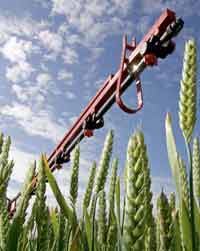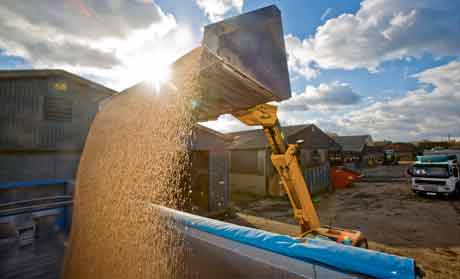Mycotoxins: Keeping the grain trade on track

Mycotoxins look like being an annual issue. Lucy de la Pasture finds out how the grain train coped last year and what it means for growers this season.
The Miller’s Tale
Challenging, that’s how Martin Savage, Trade Policy Manager for the National Association of British and Irish Millers (NABIM), describes their experience of grain from the 2008 harvest.
Alarm bells rang early in the season as sample results from mills arrived at NABIM. These showed about 10% of samples were exceeding deoxynivalenol (DON) limits (compared with 7% in 2007). But the real cause for concern was that background levels were high, indicating mycotoxins were present in most samples, though not exceeding limits.
“The harvesting period was long and protracted because of the wet conditions.” says Mr Savage. “This gave us problems with DON and zearalenone (ZON), mycotoxins produced in the field by fusarium fungi.”
A further complication of the difficult harvest, particularly for growers that market grain from May to July, is an increasing risk of ochratoxin A, a mycotoxin which can develop on moist grain during storage. “So if grain has been stored at high moisture levels or has developed a taint or smell, don’t offer it to millers,” he warns.
In the three years since EU legislation was introduced limiting the levels of DON and ZON mycotoxins in grain, the whole grain chain has been learning rapidly. And setting a legal limit is not all the legislation has done. “Growers have become responsible for food safety on raw wheat for the first time,” says Mr Savage.
Since DON testing became mandatory, carrying out a risk assessment has been an essential part of the marketing process. But as intakes at mills progressed last winter and rejections became commonplace, it became clear that the risk assessment wasn’t working, he says.
“In February we had to introduce a system of rapid DON test counts to accompany consignments of grain, which although more cost to the farmer, reduced rejections and made the system more workable.”
Breakfast cereals scarce
If the millers had it bad, the breakfast cereal manufactures had an even harder job sourcing grain that didn’t exceed legal mycotoxin limits, says Weetabix‘s Keith Turnbull. They introduced rapid DON testing as early as November to make sure grain was on spec.
“The way the EU regulations are set up, the limits get tighter as you go down through the food chain,” says Mr Turnbull. “Where the limit for raw wheat is 1250ppb, for breakfast cereals the limit is just 500ppb.”
And because mycotoxins are mostly in the bran, the main source of fibre in breakfast cereals, and they are further concentrated as the cereal is dried to a moisture content of 5%, grain needs to be lower than the legal limits for mycotoxins at intake.
“Once we had the DON situation under control, we identified issues with ZON for the first time,” says Mr Turnbull. “ZON appeared late and was a problem in raw material supply, but now testing is in place for this as well.”
It seems that the rapid testing will be here to stay, at least until the picture for harvest 2009 has been established, believes Mr Turnbull. “But now the industry is set up to manage an exceptionally bad season for mycotoxins, the whole grain chain has the opportunity to learn from it, make British farming as safe as possible, manage the risk in the crop and come out stronger than before.”
Grain traders’ troubles
From the grain traders’ perspective last season was a year of complications, says Frontier‘s head of wheat trading, Simon Christensen. Changing requirements from the milling and starch trade brought confusion with risk assessments and DON measurements for a short while.

Grain traders had contamination issues at intake after last harvest
There were issues at intake, rejections and problems with sampling, an area which is being looked at closely by The Mycotoxin Stakeholder Group, which is working to find a better sampling regime. One of the problems with mycotoxins is that they don’t occur in a homogenous way, one load can be high and another low and they’ve come from the same field.
“But the message about the importance of mycotoxins has been understood by farmers, and the supply chain will be more able to cope if it happens again,” Mr Christensen says. “Sampling remains an area of concern from the grower’s perspective. They need to be confident that the tests carried out at intake are accurate and that the wheat being imported also follows the same requirements from a testing and sampling regime to ensure a level playing field exists with their foreign counterparts.”
In the field
So why was last season so bad? Simon Edwards, fusarium expert at Harper Adams explains why the risk assessment may not have worked and how the mycotoxins occur.
“The HGCA risk assessment was based on data from 2001 to 2007 and during this time, average rainfall in the pre-harvest period was 20mm. Last year actual rainfall was in the region of 100mm, with a substantial delay to harvest because of the wet weather in August and September. None of this was factored in the model,” says Dr Edwards. “For this season, the risk assessment will be revised to take these factors into account and enable growers to identify fields at particular risk which may then require testing.”
Last year was also the first time ZON mycotoxin was a real problem. “It has a lower limit and is only produced as the crop ripens, whereas in contrast DON is produced from infection at flowering,” says Dr Edwards. “Any delay in harvest has an impact on ZON levels and this was clearly seen last harvest when more samples exceeded the limit for ZON (29%) than DON (13%). Many high ZON samples don’t make milling spec as they have low hagbergs and specific weight, so are effectively ‘screened’ out of the milling process and are less of an issue at mill intake.”
And what is the likelihood of a repeat this season? The bad news is there is a higher risk of fusarium infection than normal because there is more inoculum around as a result of high levels of fusarium head blight (FHB) last harvest. The good news is that, although the potential for a problem is there, actual rainfall during flowering (GS61-65) and pre-harvest will determine the severity of FHB, so mycotoxins issues may not occur.
“The main source of inoculum is crop debris, so crops are at greater risk following minimal cultivations and maize,” says Dr Edwards. “Late sowing also increases the risk of fusarium and many crops were late sown last season, crops following potatoes also seem more vulnerable to FHB.”
T3 decisions
So what should growers do? Consider the risks, especially predicted rainfall for the flowering period before making T3 decisions, advises Dr Edwards. “In commercial trials last year, where robust T3 fungicides were applied there were significant reductions in fusarium infection (50-70%). Even so, some samples still exceeded legal mycotoxin limits.”
In the UK levels of FHB in the crop, typically pinkish bleached ears, doesn’t necessarily correspond to levels of mycotoxins present on the grain. This is because it is only the true fusarium spp that produce mycotoxins, and FHB can be caused by Microdochium nivale and M. majus, neither of which produce mycotoxins. Of the five common fusarium species, F. gramineaum and F. culmorum are the most significant in terms of DON and ZON production.
A robust fungicide treatment at T3 can keep FHB at a low level and reduce the risk of mycotoxins occurring. But fungicide selection is important because only fungicides for fusarium control that contain triazoles or new approval Topsin WG (thiophanate-methyl), will control the true fusarium species responsible for mycotoxin production. And of these actives only those containing prothioconzole, bromuconazole and thiophanate-methyl have a label registration for actual DON reduction. While strobilurin chemistry has excellent activity on Microdochium species, it doesn’t control true fusarium with the exception of dimoxystrobin.
Agronomist Tom Scotson, Procam, says that whereas T3 decisions used to be a top-up for septoria and rust control, things have definitely changed. “Concerns with DON levels, especially in milling wheat and breakfast cereals, means that we must have a planned strategy to control fusarium pre-flowering.”
Using programmes based predominantly on prothioconazole, the standard for fusarium control, he describes thiophanate-methyl as a useful addition to the armoury, having a different mode of action to the triazoles.
Trials work carried out by Certis with thiophanate-methyl, emphasizes the importance of correct timing for optimum fusarium control, with the period from the beginning of anthesis (GS61) to mid-flowering (GS65) giving the greatest reduction in fusarium levels on the ear.
Grain chain
- Challenging season for millers in 2008
- Breakfast cereal firms had trouble with mycotoxin limits
- Complications for grain traders
- Risk assessment proved inadequate
- Consider risks before making T3 decisions this season

